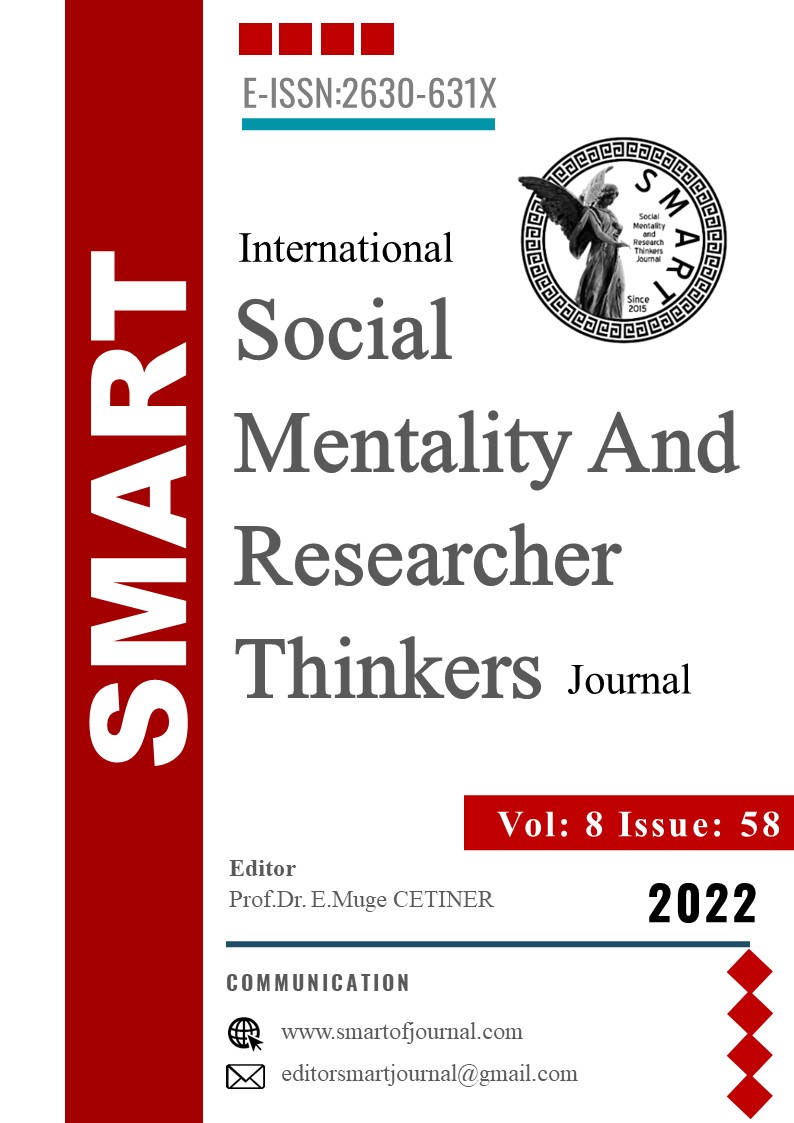Author :
Abstract
Bu araştırmada “Ergenler İçin Yıkıcı Davranış Ölçeği- EYDÖ(Disruptive Behavior Scale for Adolescents (DISBA))”nin geçerlik ve güvenirlik çalışmasının yapılması amaçlanmıştır. Araştırmanın çalışma grubunu 2020-2021 eğitim-öğretim yılında Osmaniye İl Milli Eğitim Müdürlüğüne bağlı resmi liselere devam eden 15-18 yaş aralığında 588 öğrenci oluşturmuştur. Araştırmada araştırmacı tarafından hazırlanan öğrencilere ve ailelerine ait demografik bilgileri elde etmek amacıyla Genel Bilgi Formu ve öğrencilerin yıkıcı davranışlarını değerlendirmek için Ergenler İçin Yıkıcı Davranış Ölçeği (Disruptive Behavior Scale for Adolescents (DISBA)) kullanılmıştır.
Araştırmada ölçeğin geçerlilik çalışmaları kapsamında kapsam geçerliği ve yapı geçerliği, güvenirlik kapsamında Cronbach Alfa (α) katsayısı hesaplanmıştır. Güvenirlik kapsamında Cronbach alfa katsayısı tüm ölçek için 0,97 bulunmuştur. Türkçe’ye uyarlama süreci sonrasında ölçek 29 maddeden ve agresif okul davranışı, sınıfa meydan okuma, okulun önemsizliği ve otoriteye meydan okuma olmak üzere dört alt boyuttan oluşmaktadır. Ölçekten alınabilecek en düşük puan 0 en yüksek puan 87’dir. Ergenler İçin Yıkıcı Davranış Ölçeği; 15-18 yaş aralığındaki ergenlerin yıkıcı davranışlarını değerlendirmede kullanılabilecek geçerli ve güvenilir bir ölçek olduğu sonucuna ulaşılmıştır.
Keywords
Abstract
In this study, it is aimed to conduct the validity and reliability study of the "Disruptive Behavior Scale for Adolescents" (DIBSA). The study group of the research consisted of 588 students who go to high schools every day between the ages of 15-18, which affiliated to Osmaniye Provincial Directorate of National Education in the 2020-2021 academic year. In the study, the General Information Form was used to obtain demographic information about the students and their families prepared by the researcher, and the DISBA was used to evaluate the destructive behaviors of the students.
In the study, content validity and construct validity were calculated within the scope of validity studies of the scale, and coefficient of Cronbach Alpha was calculated within the scope of reliability. Within the scope of reliability, the coefficient of Cronbach's alpha was found to be 0.97 for the whole scale. After the adaptation process into Turkish, the scale consists of 29 items and four sub-dimensions for as aggressive school behavior, challenging to class, the insignificance of the school, and challenging to authority. The lowest point that can be taken from the scale is 0, and the highest point is 87. Disruptive Behavior Scale for Adolescents; it has been concluded that it is a valid and reliable scale that can be used to evaluate the disruptive behaviors of adolescents between the ages of 15-18.
Keywords
- Balcı, E. (2019). Yetiştirme Yurdunda Kalan Ergenlerin Saldırganlık Ve Öfke Düzeyleri Arasındaki İlişkinin
- Balcı, E. (2019). Yetiştirme Yurdunda Kalan Ergenlerin Saldırganlık Ve Öfke Düzeyleri Arasındaki İlişkinin İncelenmesi. Yüksek Lisans Tezi. İstanbul Sabahattin Zaim Üniversitesi Sosyal Bilimler Enstitüsü
- Bollen, K. A. (1989). A new incremental fit index for general structural equation models, Sociological Methods & Research, 17(3), 303-316.
- Browne, M., & Cudeck, R. (1993). Alternative ways of testing structural equation models. Testing Structural Equation Models London: Sage.
- Çelik, H. Ve Otrar M. (2009). Saldırganlık Envanterinin Türkçeye Uyarlanması: Geçerlik ve güvenirlik çalışmaları. Marmara Üniversitesi Eğitim Bilimleri Dergisi, 29(29), 101-120.
- Dray, J., Bowman, J., Freund, M., Campbell, E., Hodder, R., Lecathelinais , C., & Wiggers , J. (2016). Mentalhealth problems in a regional population of Australian adolescents: association with socio-demographiccharacteristics. Child and Adolescent Psychiatry and Mental Health, 10(32), 1-11. doi:10.1186/s13034-016-Ercan, E., Ercan, E. S., Akyol-Ardıç, Ü. ve Uçar, S. (2016). Çocuklar için Saldırganlık Ölçeği Anne-Baba Formu:Türkçe geçerlilik ve güvenilirlik çalışması. Anadolu Psikiyatri Dergisi, 17(Ek1), 77-84.
- Hair, J.F., Black, W.C., Babin, B.J., Anderson R.E, Tatham, R., L. (2010). Multivariate data analysis. United States: Prentice-Hall, Inc
- Harrington, D. (2009). Confirmatory factor analysis. Oxford university press. Analysis. Seventh Edition, Pearson: New Jersey.
- Hu, L. T., & Bentler, P. M. (1999). Cutoff criteria for fit indexes in covariance structure analysis:Conventional criteria versus new alternatives. Structural equation modeling: a multidisciplinary journal, 6(1), 1-55.
- Karimy, M., Niknami, S., Heidarnia, A. R., Hajizadeh, I., & Montazeri, A. (2013). Prevalence andDeterminants of Male Adolescents’ Smoking in Iran: An Explanation Based on the Theory of Planned Behavior. Iranian Red Crescent Medical Journal, 15(3), 197-193. doi:10.5812/ircmj.3378
- Karimy, M., Fakhri, A., Vali, E., Vali, F., Veiga, F. H., Stein, L. A., & Araban, M. (2018). Disruptive behaviorscale for adolescents (DISBA): development and psychometric properties. Child and adolescent psychiatry and mental health, 12(1), 1-7.
- Kline, R. B. (2005). Principles and practice of structural equation modeling. New York: Guilford Press.
- Masood, M., Zahra, A., Mansoor, S., Abbas, A., Fereshteh, S., Azhar, M. M.& Hassanzadeh, A. (2008).Effects of parent training on salivary cortisol in children and adolescents with disruptive behavior disorder. Journal of research in medical sciences, 13(2), 69-74.
- Nock, M. K., Kazdin, A., Hiripi, E., & Kessler, R. (2006). Prevalence, Subtypes, and Correlates of DSM-IVConduct Disorder in the National Comorbidity Survey Replication. Psychological Medicine, 36(5), 699-710. doi:10.1017/S0033291706007082
- Schumacker R. E, Lomax R. G. A (2010). Beginner's Guide to Structural Equation Modeling. New York: Taylor & Francis Group.
- Stringaris, A., Maughan, B., Copeland, W. S., Costello, E., & Angold, A. (2013). Irritable Mood as aSymptom of Depression in Youth: Prevalence, Developmental, and Clinical Correlates in the Great SmokyMountains Study. Journal of the Amerikan Academy of Child & Adolesent Psychiatry, 52(8), 831–840 . doi:https://doi.org/10.1016/j.jaac.2013.05.017
- Tan, Ş. (2008).Öğretimde ölçme ve değerlendirme KPSS el kitabı., 2. Baskı Ankara:Pegem Akademi.
- Tunç, Z., & Kolburan, Ş. (2019). Ergenlik Döneminde Benlik Saygısı ile Sigara Bağımlılığı Arasındakiİlişkinin İncelenmesi. Aydın Toplum ve İnsan, 5(1), 55-70. https://dergipark.org.tr/tr/pub/aitdergi/issue/45818/578339 adresinden alındı
- Undheim, A. M., Lydersen , S., & Kayed, N. S. (2016). Do school teachers and primary contacts in residentialyouth care institutions recognize mental health problems in adolescents? Child and Adolescent Psychiatry and Mental Health, 10(19), 1-11. doi:10.1186/s13034-016-0109-4
